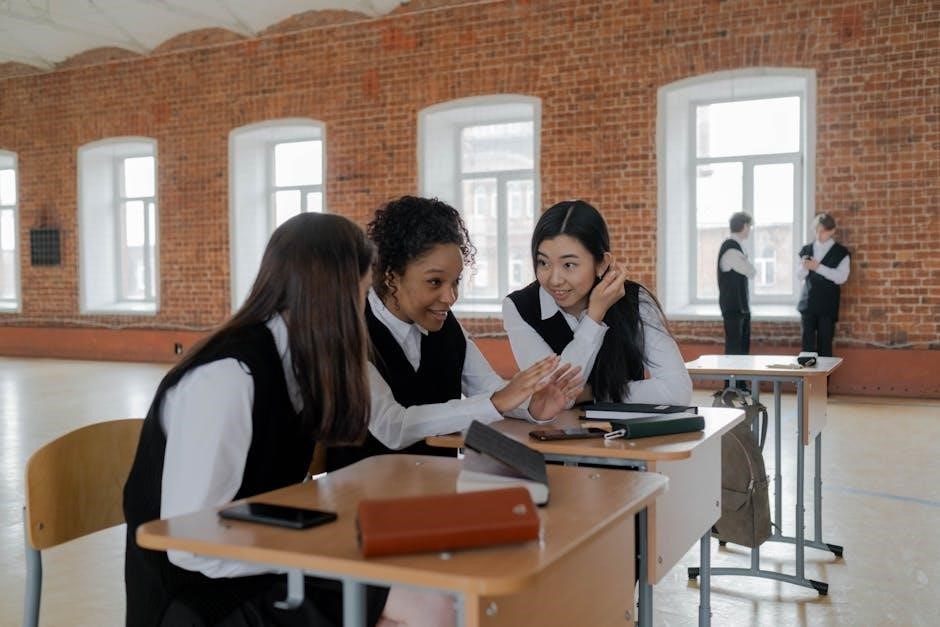
Ice breakers are fun activities designed to help high school students reduce anxiety, build connections, and foster collaboration in a comfortable learning environment, encouraging creativity and engagement․
Why Ice Breakers Are Important for High School Students
Ice breakers are essential for high school students as they help reduce anxiety and tension, fostering a welcoming environment․ They encourage teamwork, improve communication, and create opportunities for students to connect on a personal level․ By breaking down social barriers, ice breakers prepare students for collaborative learning and help them feel more comfortable in new or unfamiliar settings, promoting a sense of inclusivity and readiness for engaging with new content․

Types of Ice Breaker Activities
Ice breaker activities are categorized into group and individual exercises, designed to encourage teamwork, collaboration, and personal sharing, helping students connect and ease social interactions effectively․
Group Ice Breakers
Group ice breakers are activities designed for multiple participants, fostering teamwork and collaboration․ Examples include collaborative cooking challenges, where students work together to prepare a meal, and interactive games like “Human Bingo,” which encourages mingling and problem-solving․ These activities help students bond, break down social barriers, and feel comfortable in a shared environment, promoting unity and cooperation while keeping the atmosphere light and enjoyable for everyone involved in the group setting․
Individual Ice Breakers
Individual ice breakers focus on personal participation, allowing students to share thoughts or complete simple tasks independently․ Activities like “Two Truths and a Lie” or “If I Could․․․” encourage self-expression without group pressure․ These exercises help students feel comfortable sharing their identities and interests, fostering a sense of belonging and easing social interactions in a low-stakes environment․ They are ideal for quiet or shy students who may find group activities overwhelming, promoting confidence and gradual connection with peers․
Benefits of Using Ice Breakers in the Classroom
Ice breakers foster a welcoming atmosphere, reduce anxiety, and encourage student interaction, creating a foundation for active participation and meaningful learning experiences in high school settings․
Reducing Anxiety and Tension
Ice breakers play a crucial role in easing anxiety and tension among high school students, helping them feel more comfortable in new or unfamiliar environments․ By engaging in lighthearted activities, students can gradually open up and shed their fears of judgment or embarrassment․ These activities create a relaxed atmosphere, allowing them to connect with peers on a personal level and build confidence․ This transition from nervousness to camaraderie lays a strong foundation for collaborative learning and positive classroom dynamics․
Improving Student Collaboration and Communication
Ice breakers foster meaningful interactions, helping high school students develop essential teamwork and communication skills․ By engaging in shared activities, students learn to express themselves, listen actively, and appreciate diverse perspectives․ These exercises encourage collaboration, breaking down social barriers and creating a supportive environment where everyone feels heard․ Enhanced communication skills empower students to work together more effectively, leading to stronger relationships and a more cohesive classroom community․

How to Choose the Right Ice Breaker Activity
Selecting the right ice breaker involves considering group size, student ages, and interests to ensure the activity is engaging, appropriate, and effective for fostering connections․
Considering the Size and Dynamics of the Group
When choosing an ice breaker, it’s essential to consider the group’s size and dynamics․ Smaller groups may benefit from intimate, interactive activities, while larger groups require structured, manageable exercises․ High-energy activities suit lively classes, while low-key games work better for reserved students․ Tailoring the activity to the group’s size and energy ensures participation and engagement, fostering a positive environment for connection and collaboration among high school students․
Aligning Activities with the Age and Interests of Students
Ice breakers should align with students’ ages and interests to ensure engagement․ For high school students, activities that incorporate technology or pop culture, such as sharing favorite apps or hypothetical scenarios, resonate well․ Relatable topics like hobbies or future goals also spark meaningful conversations․ Tailoring activities to their interests fosters enthusiasm and participation, making the experience enjoyable and relevant for teenagers in a high school setting․
Implementing Ice Breakers Effectively
Effective implementation involves clear planning, setting objectives, and creating a positive atmosphere․ Guide activities smoothly to ensure participation, fostering connections while maintaining engagement and focus among students․
Step-by-Step Guide to Conducting an Ice Breaker Session
Start by setting clear objectives for the session․ Prepare activities that align with the group’s size and age․ Introduce the activity with enthusiasm and explain its purpose․ Encourage participation by creating a safe and inclusive environment․ Monitor time to keep the session engaging․ After the activity, debrief to highlight key takeaways․ Conclude by reinforcing connections made and setting a positive tone for future interactions․

Tips for Making Ice Breakers Successful
Plan activities carefully, provide clear instructions, and ensure appropriate timing․ Create a welcoming environment where all students feel comfortable participating and engaging with their peers․
Timing and Duration of Activities
Timing is crucial for successful ice breakers․ Activities should last 10–15 minutes to maintain engagement without overwhelming students․ Adjust duration based on group size and energy levels to ensure participation․ Shorter activities work best for large groups, while longer ones foster deeper connections in smaller settings․ Be mindful of the class schedule to avoid rushing or cutting into valuable lesson time․ Clear timeframes help students stay focused and ensure a smooth transition to the next activity․
Encouraging Participation and Inclusivity
Creating a safe and inclusive environment is essential for encouraging participation in ice breaker activities․ High school students often feel anxious in new settings, so it’s important to ensure everyone feels valued and heard․ Start with clear expectations and encourage voluntary sharing to avoid pressure․ Incorporate activities that allow students to express themselves in ways they feel comfortable, whether through speaking, writing, or non-verbal engagement․ This approach fosters a sense of belonging and ensures all students, regardless of their background or personality, can contribute effectively․
Examples of Fun and Engaging Ice Breaker Activities
Activities like “Two Truths and a Lie” and “Human Bingo” are engaging, fostering interaction and laughter while helping students connect through shared experiences and interests․
Low-Preparation Ice Breakers
Low-preparation icebreakers are quick, easy, and require minimal materials, making them ideal for high school students․ Activities like “If You Had 25 Hours a Day” or “Delete All But Three Apps” spark fun conversations․ Students can also line up based on preferences or birthdays, fostering connections․ These activities are simple, engaging, and effective for breaking the ice without extensive planning, ensuring a smooth start to collaboration and interaction in the classroom․
Creative and Interactive Ice Breakers
Creative icebreakers engage high school students through interactive and imaginative activities․ Examples include group challenges, like planning a meal together, which fosters teamwork and investment in a shared goal․ Students can also participate in activities where they think of shared experiences, such as playing catch or walking to school together, sparking meaningful conversations․ These activities encourage creativity, collaboration, and connection, making them ideal for breaking the ice in a dynamic and engaging way․

Using Digital Tools for Virtual Ice Breakers
Digital tools like Kahoot, Mentimeter, and Google Jamboard enable engaging virtual icebreakers, fostering connections and collaboration among high school students through interactive games and real-time interactions․
Recommended Apps and Platforms for Online Interactions
Popular apps like Kahoot, Mentimeter, and Google Jamboard are excellent for virtual icebreakers․ These tools allow students to engage in interactive quizzes, polls, and collaborative brainstorming sessions․ Kahoot’s gamified approach fosters friendly competition, while Mentimeter enables anonymous participation, encouraging shy students to contribute․ Google Jamboard supports real-time collaboration, making it ideal for group activities․ These platforms are user-friendly and accessible, ensuring seamless interaction for high school students in online settings․

Common Mistakes to Avoid When Leading Ice Breakers
Forcing participation, overcomplicating activities, and ignoring students’ comfort levels can hinder the effectiveness of ice breakers, creating discomfort instead of fostering connections and engagement․
Forcing Participation and Overcomplicating Activities
Forcing participation can create discomfort and anxiety, undermining the purpose of ice breakers․ Overcomplicating activities may confuse students or make them feel overwhelmed․ To avoid this, ensure activities are simple and inclusive․ Offer opt-out options to respect individual comfort levels․ This approach fosters a positive environment, encouraging genuine interaction and engagement without pressure․

Cultural and Inclusivity Considerations
Cultural sensitivity is crucial when designing ice breakers․ Activities must respect diverse backgrounds and preferences, ensuring inclusivity․ Always consider students’ comfort levels and potential cultural differences to create a welcoming environment․
Ensuring Activities Are Appropriate for All Students
Ice breaker activities must be culturally sensitive and inclusive to ensure all students feel comfortable․ Educators should involve students in planning or provide options for participation․ Avoid activities that may inadvertently exclude or offend based on cultural, religious, or personal backgrounds․ Offering alternatives for students who prefer not to participate fully can foster a respectful environment․ By being mindful of these considerations, educators can create activities that celebrate diversity and promote inclusivity for all students․
Ice breakers are essential for reducing anxiety, fostering collaboration, and creating a positive learning environment, helping high school students connect and thrive socially and academically․
Final Thoughts on the Importance of Ice Breakers
Ice breakers are transformative for high school students, fostering connections, easing social nerves, and creating a supportive environment․ They encourage creativity, collaboration, and inclusivity, setting the stage for a positive and engaging academic experience while helping students build lasting relationships and confidence․